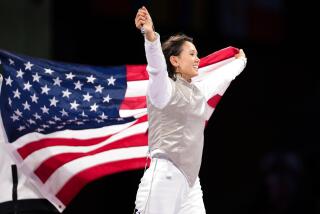Fencing, Italian-Style : European Master Would Take Sport Out of Soundstage Shadows
- Share via
In the 1400s, Italian fencing instructors traveled throughout Europe spreading the techniques of swordplay. Five centuries later the Italians are at it again, but this time America is the target of their educational thrusts.
Diego Tesser, a veteran of international fencing competition who has worked for the Italian national training center the last three years, wrote to the U. S. Fencing Assn. several months ago expressing an interest in coming to the States and participating in a youth camp.
Last week he joined the staff of the Salle Gascon Club as an instructor during the Pacific Coast Section national camp offered at the Westside Fencing Center in Culver City.
“I just want to give you a hand,” Tesser said through an interpreter, Phyllis Elliott, the camp manager.
“In my opinion, we are now the first in the world as a team,” he said of the Italian national squad. “We have the best team in the foil, male and female, and we are good in epee and sabre.”
Differences in Training
Although Tesser said certain moves and weapon grips are essentially universal in the international fencing community, there are several differences from country to country, namely in training and in the approach to the sport.
“For us, it’s treated as a sport,” he said. “It’s government supported and the national camps are interested in producing champions.”
In the U. S., fencing isn’t just another sport. It barely ripples the cloak of anonymity it’s shrouded in, overshadowed by baseball, football, basketball, golf, tennis and just about every other sport.
“One of the greatest weaknesses of the sport is that it doesn’t get much publicity here,” said Ted Katzoff, director of the Westside center and fencing teacher at UCLA and Harvard and Oakwood high schools. “It’s often front-page news in Europe.”
Katzoff said economics is part of the problem.
‘The Money Element’
“Tennis and golf were basically unknown until they started offering big money prizes. It’s not even a matter of the quality of the sport. It’s just the money element.”
Still, Katzoff said fencing’s greatest obstacle here is its inseparable link with the make-believe of Hollywood. After all, most Americans can trace their only exposure to swordplay to the silver screen and watching Errol Flynn or Douglas Fairbanks Sr. wielding their blades for God, glory and gold.
And even though fencing was an event at the 1896 Olympic Games, Katzoff said it is regarded more as an artifact of the romantic celluloid era than as a sport.
Fencing is a serious sport elsewhere. Tesser said European children first pick up a blade at age 8, and only after weeks or months of training.
“There’s an element of patience,” he said. “You can’t just go out and start fencing. You first have to tune the body.”
Americans Deadly Serious
But Katzoff said his students, most in their late teens, handle a sword right away. Despite that different approach, some Americans are deadly serious.
“I want to become a world champion,” said Chanel-France Summers, one of the 19 12-to-20-year-olds at the weeklong camp.
Summers, 16, said she had never seen fencing other than in movies. But her mother loved the sport from watching the same movies and bought tickets to fencing at the 1984 Olympics.
“After I saw it, I really liked it. It’s just such a beautiful art,” the daughter said.
Al Carter, 15, a junior at Harvard High School, said he had always played the more common sports such as basketball and baseball, but two years ago his mother encouraged him to try something a little different.
Why Not Fencing?
And what, he figured, could be more different than fencing?
“It just fascinated me,” said Carter, who participated at the camp. “It’s the most complicated sport I’ve ever played.
“You have to drill for hours just to learn one move. Everything has to be precise and perfect.”
Carter has championship aspirations after finishing 13th out of 116 in the men’s foil at a national tournament in New York in June.
Katzoff doesn’t expect all of his students to strive for national or world titles as is expected of the youths at Italian national camps. He is aware that some aren’t cut from championship material and are solely interested in a workout.
“I’m the worst one here (at the camp), but I really love it,” said Jacinda Denison, 19, a junior at UCLA, who got involved in the sport to win the heart of a young man.
Sticking With It
“I started going out with a new guy and he was on the UCLA fencing team, so I though it would impress him if I started fencing. It didn’t impress him, but I stuck with it.”
Denison said she was never much of an athlete and even in elementary school was picked last for games.
“But in fencing, even if I lose a bout, I feel good about it because I know that I’ve tried my best,” she said while adjusting a bandage protecting an injured hamstring. “I don’t think you get that feeling from any other sport. In football, there’s a whole team to make you feel bad if you lose, and in tennis there’s a lot of people watching you.”
J. Granzow, 14, began fencing last September and opted to fence this summer rather than play a sixth consecutive year of baseball.
“Fencing’s not the most common sport, but it’s a lot of fun,” he said. “In baseball, you just have to hit the ball and field it.
“But in fencing, there’s so much to learn and so many ways to do it. There’s not just one way to fence. That’s what’s so great about this camp. You get to learn from lots of different people.”
Of course, exposing other people to their style of fencing isn’t an innovation for the Italians. They’ve been doing that for hundreds of years.
More to Read
Go beyond the scoreboard
Get the latest on L.A.'s teams in the daily Sports Report newsletter.
You may occasionally receive promotional content from the Los Angeles Times.










